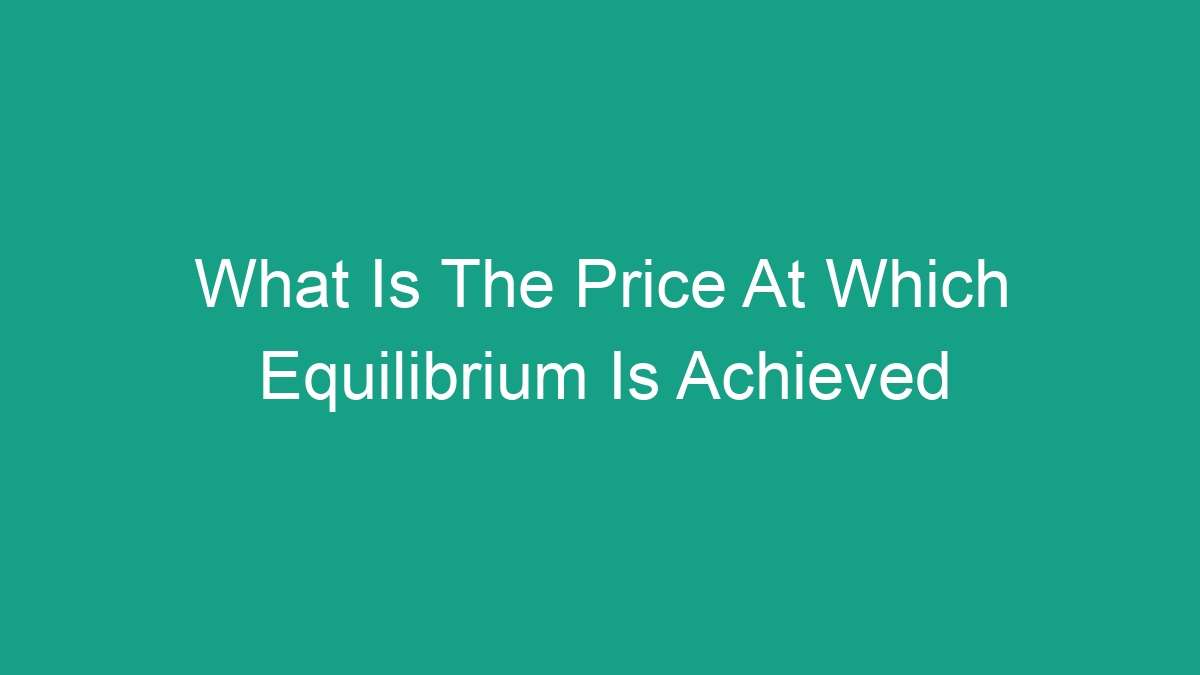
Understanding Equilibrium Price
In economics, the concept of equilibrium price is crucial in understanding the dynamics of supply and demand in a market. Equilibrium price is the price at which the quantity demanded by consumers equals the quantity supplied by producers, resulting in a market where there is neither a surplus nor a shortage of the good or service. This is often represented graphically as the point where the demand and supply curves intersect.
Determining Factors of Equilibrium Price
Several factors influence the equilibrium price of a good or service:
- Demand and Supply: Changes in consumer preferences, income, and population can shift the demand curve, while changes in technology, input prices, and government policies can shift the supply curve.
- Price Elasticity: The price elasticity of demand and supply also affects how much a change in price will affect the quantity bought or sold, thus influencing the equilibrium price.
- External Factors: External factors such as government regulations, subsidies, and taxes can also impact the equilibrium price.
Calculating Equilibrium Price
The equilibrium price can be calculated using the following steps:
- Determine the demand and supply functions for the good or service.
- Set the demand and supply functions equal to each other to find the equilibrium quantity.
- Substitute the equilibrium quantity into either the demand or supply function to find the equilibrium price.
Implications of Equilibrium Price
The equilibrium price has several implications for both producers and consumers:
- Producer Surplus: At the equilibrium price, producers are able to sell all the goods they are willing to at the market price, resulting in producer surplus.
- Consumer Surplus: Similarly, consumers are able to purchase the goods they desire at a price lower than what they were willing to pay, resulting in consumer surplus.
- Market Efficiency: Achieving equilibrium price leads to market efficiency, where resources are allocated to their most valuable uses.
Factors Affecting Equilibrium Price
Several factors can affect the equilibrium price of a good or service:
- Changes in Demand: If there is an increase in demand for a product, the equilibrium price will rise as producers try to meet the higher demand. Conversely, a decrease in demand will lead to a lower equilibrium price.
- Changes in Supply: An increase in supply will result in a lower equilibrium price, while a decrease in supply will lead to a higher price.
- Government Intervention: Government policies such as price controls, taxes, and subsidies can also impact the equilibrium price of a product.
Real-World Examples of Equilibrium Price
Equilibrium price can be observed in various markets, such as the following:
- Real Estate: The equilibrium price of real estate is affected by factors such as location, demand from buyers, and the supply of available properties.
- Stock Market: Equilibrium price in the stock market is influenced by the demand and supply for shares of a particular company, as well as overall market conditions.
- Agricultural Products: Factors such as weather conditions, government subsidies, and consumer preferences can impact the equilibrium price of agricultural products.
Conclusion
Understanding the concept of equilibrium price is essential in analyzing market dynamics and making informed economic decisions. By considering the factors that influence equilibrium price and its implications for both producers and consumers, individuals, businesses, and policymakers can better navigate market conditions.
FAQs
What happens when the price is above the equilibrium price?
When the price is above the equilibrium price, there is a surplus of the good or service, as the quantity supplied exceeds the quantity demanded. This can lead to downward pressure on prices as producers try to sell off excess inventory.
What happens when the price is below the equilibrium price?
When the price is below the equilibrium price, there is a shortage of the good or service, as the quantity demanded exceeds the quantity supplied. This can lead to upward pressure on prices as consumers compete for the limited available supply.
How does the equilibrium price change over time?
The equilibrium price can change over time due to shifts in demand and supply, changes in consumer preferences, technological advancements, and government policies. These factors can lead to a new equilibrium price as the market adjusts to the new conditions.



